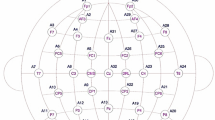Summary
In a group of 30 adults with impaired hearing, objective thresholds defined with 40 Hz middle latency responses (MLR) were compared with subjective audiometric measures. Frequencies of 0.25, 0.5, and 1 kHz were studied. In order to guarantee a good frequency specificity, subjects presenting large high-frequency hearing loss were particularly chosen. The 40-Hz MLR thresholds were generally worse than the audiometric measures. The average difference was around 12 dB, but in about one-third of the cases it was between 20 and 30 dB. Although not perfect, 40-Hz MLR estimates on low frequencies can be very helpful and deserve further consideration, especially in children.
Similar content being viewed by others
References
Aran JM, Charlet De Sauvage R, Pelerin J (1971) Comparaison des seuils électrocochléographiques et de l'audiogramme: étude statistique. Rev Laryngol 92: 477–491
Conraux C, Dauman R, Féblot P (1981) Potentiels évoqués auditifs rapides dérivés. Audiology 20: 382–393
Davis H, Hirsh SK (1976) The audiometric utility of brain-stem responses to low-frequency sounds. Audiology 15: 181–195
Don M, Eggermont JJ, Brackmann DE (1979) Reconstruction of the audiogram using brain-stem responses and high-pass noise masking. Ann Otol Rhinol Laryngol [Suppl] 57: 1–20
Eggermont JJ (1976) Electrocochleography. In: Keidel WD and Neff WD (eds) Handbook of sensory physiology, vol. V/3, pp 625–706
Galambos R, Makeig S, Talmachoff P (1981) A 40 Hz auditory potential recorded from the human scalp. Proc Natl Acad Sci US 78: 2643–2647
Klein AJ (1983) Properties of the brain-stem response slow-wave component I. Latency, amplitude and threshold sensitivity. Arch Otolarnygol 109: 6–12
Mendel MI (1975) Effects of secobarbital on the early components of the auditory evoked potentials. Rev Laryngol 96: 178–184
Mendel MI, Goldstein R (1971) Early components of the averaged electroencephalic response to constant level clicks during all-night sleep. J Speech Hear Res 14: 829–840
Picton TW, Woods DL, Baribeau-Braun Y, Healey TMG (1977) Evoked potential audiometry. J Otolarnygol 6: 90–199
Shallop JK (1983) Electric response audiometry. Adv Oto Rhino Laryngol 29: 124–139
Shallop JK, Osterhammel PA (1983) A comparative study of measurements of SN-10 and the 40/sec middle latency responses in newborns. Scand Audiol 12: 83–95
Stapells DR, Picton TW (1981) Technical aspects and brain-stem evoked potential audiometry using tones. Ear Hear 2: 20–29
Szyfter W, Dauman R, Charlet de Sauvage R (1983) 40 Hz MLR to low frequency tone-pips in normally-hearing adults. J Otolarnygol (in press)
Author information
Authors and Affiliations
Rights and permissions
About this article
Cite this article
Dauman, R., Szyfter, W., de Sauvage, R.C. et al. Low frequency thresholds assessed with 40 Hz MLR in adults with impaired hearing. Arch Otorhinolaryngol 240, 85–89 (1984). https://doi.org/10.1007/BF00464350
Received:
Accepted:
Issue Date:
DOI: https://doi.org/10.1007/BF00464350




